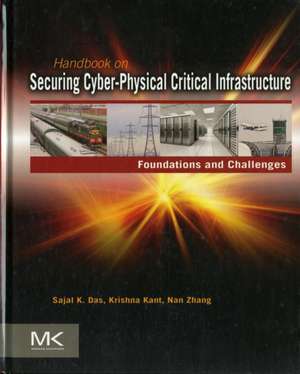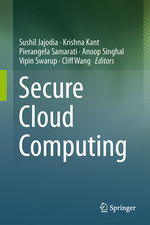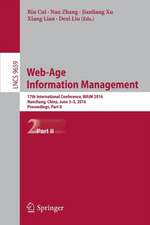Handbook on Securing Cyber-Physical Critical Infrastructure
Autor Sajal K Das, Krishna Kant, Nan Zhangen Limba Engleză Hardback – 15 mar 2012
- Addresses the technical challenges facing design of secure infrastructures by providing examples of problems and solutions from a wide variety of internal and external attack scenarios
- Includes contributions from leading researchers and practitioners in relevant application areas such as smart power grid, intelligent transportation systems, healthcare industry and so on
- Loaded with examples of real world problems and pathways to solutions utilizing specific tools and techniques described in detail throughout
Preț: 405.57 lei
Preț vechi: 581.81 lei
-30% Nou
Puncte Express: 608
Preț estimativ în valută:
77.63€ • 84.35$ • 65.25£
77.63€ • 84.35$ • 65.25£
Carte tipărită la comandă
Livrare economică 14-28 aprilie
Preluare comenzi: 021 569.72.76
Specificații
ISBN-13: 9780124158153
ISBN-10: 0124158153
Pagini: 848
Dimensiuni: 191 x 235 x 53 mm
Greutate: 1.88 kg
Editura: ELSEVIER SCIENCE
ISBN-10: 0124158153
Pagini: 848
Dimensiuni: 191 x 235 x 53 mm
Greutate: 1.88 kg
Editura: ELSEVIER SCIENCE
Public țintă
Researchers and security practitioners in relevant application areas such as smart power grid, transportation systems, communication networks, etc. The handbook is also intended to be suitable for advanced courses and seminars as well as graduate students working on various facets of security in cyber and physical systems.Cuprins
Introduction: Securing Cyber-Physical Infrastructures--An OverviewPart 1: Theoretical Foundations of SecurityChapter 1: Security and Vulnerability of Cyber-Physical Infrastructure Networks: A Control-Theoretic ApproachChapter 2: Game Theory for Infrastructure Security – The Power of Intent-Based Adversary ModelsChapter 3: An Analytical Framework for Cyber-Physical NetworksChapter 4: Evolution of Widely Spreading Worms and Countermeasures : Epidemic Theory and ApplicationPart 2: Security for Wireless Mobile NetworksChapter 5: Mobile Wireless Network SecurityChapter 6: Robust Wireless Infrastructure against Jamming AttacksChapter 7: Security for Mobile Ad Hoc NetworksChapter 8: Defending against Identity-Based Attacks in Wireless NetworksPart 3: Security for Sensor NetworksChapter 9: Efficient and Distributed Access Control for Sensor NetworksChapter 10: Defending against Physical Attacks in Wireless Sensor NetworksChapter 11: Node Compromise Detection in Wireless Sensor NetworksPart 4: Platform SecurityChapter 12: Hardware and Security: Vulnerabilities and SolutionsChapter 13: Languages and Security: Safer Software Through Language and Compiler TechniquesPart 5: Cloud Computing and Data SecurityChapter 14: Protecting Data in Outsourcing ScenariosChapter 15: Data Security in Cloud ComputingChapter 16: Secure Mobile Cloud ComputingChapter 17: Relation Privacy Preservation in Online Social NetworksPart 6: Event Monitoring and Situation AwarenessChapter 18: Distributed Network and System Monitoring for Securing Cyber-Physical InfrastructureChapter 19: Discovering and Tracking Patterns of Interest in Security Sensor StreamsChapter 20: Pervasive Sensing and Monitoring for Situational AwarenessChapter 21: Sense and Response Systems for Crisis ManagementPart 7. Policy Issues in Security ManagementChapter 22: Managing and Securing Critical Infrastructure -- A Semantic Policy and Trust-Driven ApproachChapter 23: Policies, Access Control, and Formal Methods Chapter 24: Formal Analysis of Policy based Security Configurations in Enterprise NetworksPart 8: Security Issues in Real-World SystemsChapter 25: Security and Privacy in the Smart GridChapter 26: Cyber-physical Security of Automotive Information TechnologyChapter 27: Security and Privacy for Mobile Healthcare (m-Health) SystemsChapter 28: Security and Robustness in the Internet InfrastructureChapter 29: Emergency Vehicular NetworksChapter 30: Security Issues in VoIP Telecommunication Networks
Recenzii
"This impressive collection presents different viewpoints on the security of cyber-physical infrastructure. With more than 40 different contributors and 30 chapters organized in eight parts, the authors provide a unique introduction to the current state of the art in this field. The recent rise in both security awareness and the criticality of cyber-physical systems justifies the publishing of such a comprehensive book." --ComputingReviews.com, March 2013
























